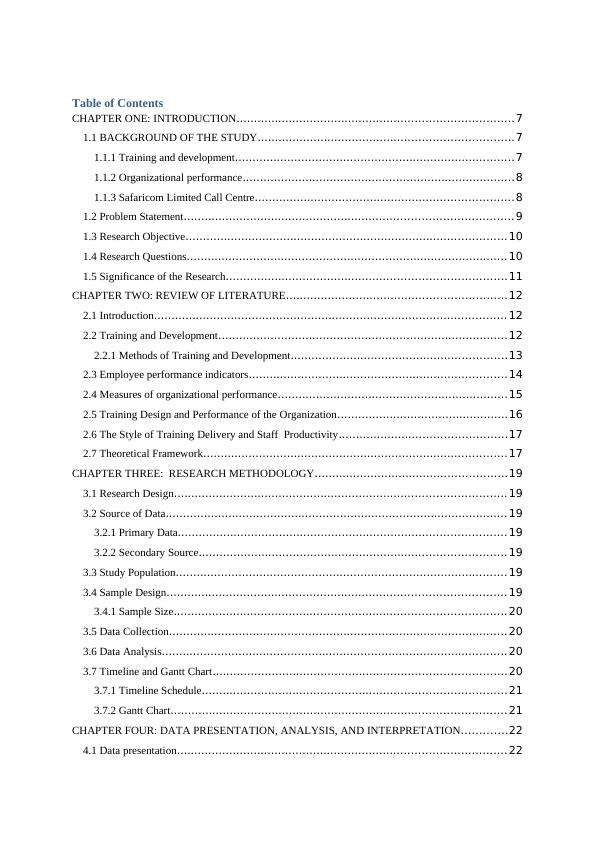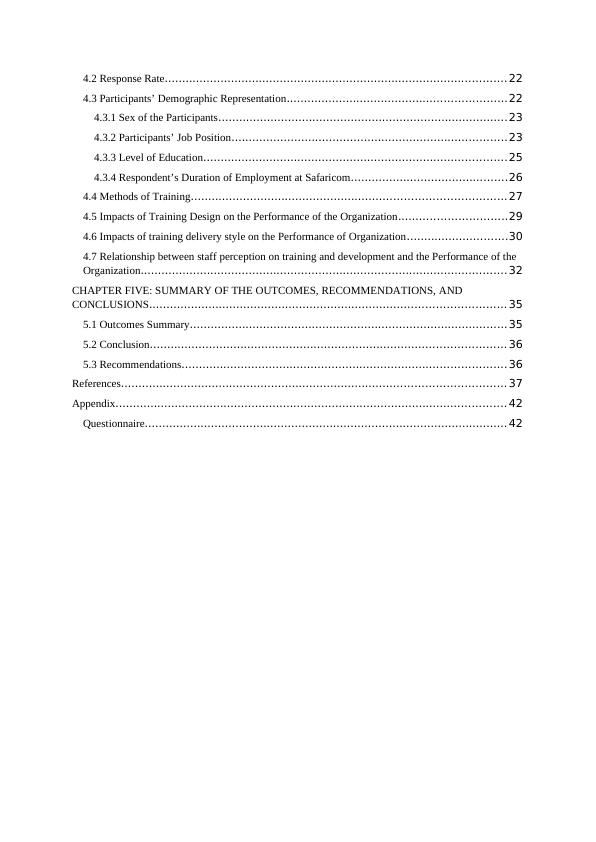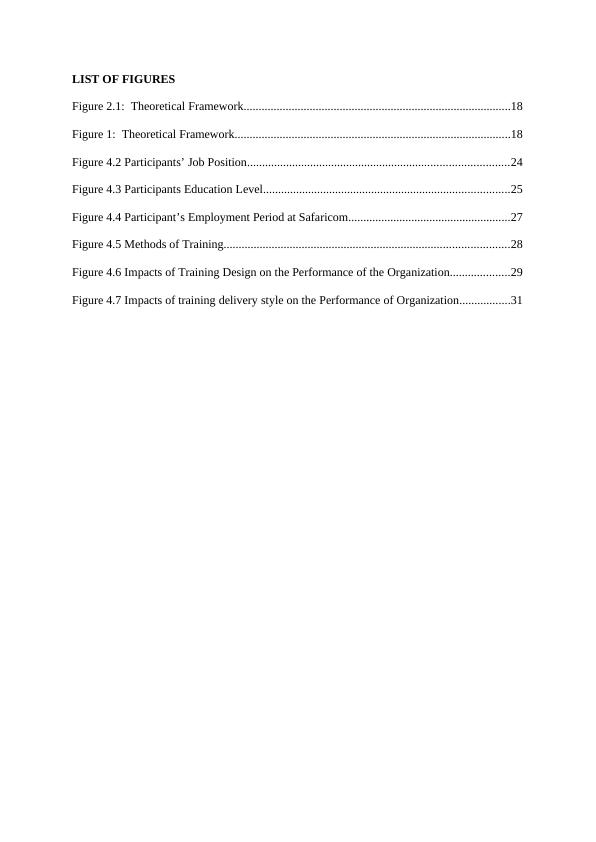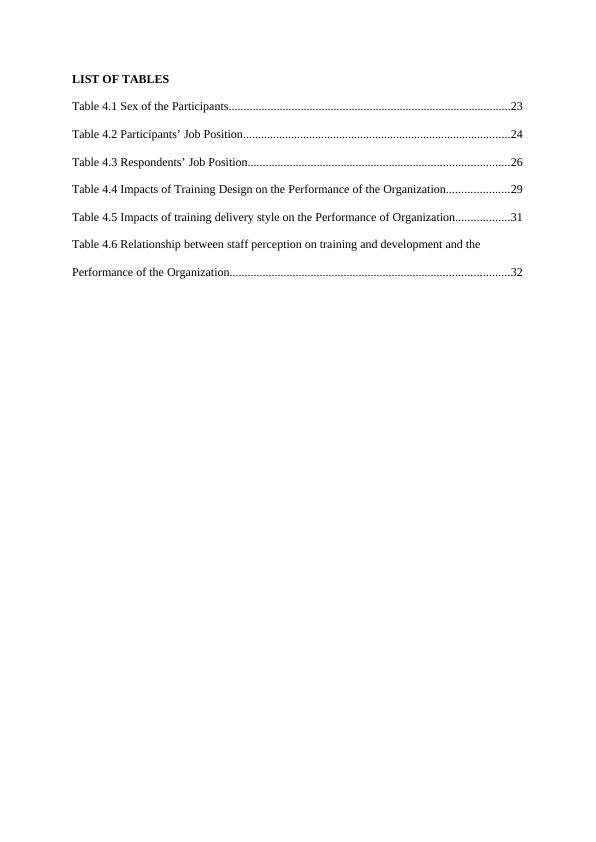Ask a question from expert
Impacts of Training and Development on Performance : Case Study
44 Pages9148 Words48 Views
Added on 2020-04-21
Impacts of Training and Development on Performance : Case Study
Added on 2020-04-21
BookmarkShareRelated Documents
THE IMPACT OF TRAINING AND DEVELOPMENT ON ORGANIZATIONAL
PERFORMANCE: A Case Study of Safaricom Ltd Calling Centre.
Student’s Name:
Professor’s Name:
Course Title:
Date:
PERFORMANCE: A Case Study of Safaricom Ltd Calling Centre.
Student’s Name:
Professor’s Name:
Course Title:
Date:

EXECUTIVE SUMMARY
The study focused on investigating the impacts of training and development on the
performance of organization with Safaricom Call center as a case study. The gap analysis was
arrived at through a thorough review of extant literature relevant to the study topic. Various
literature on the assessment of the research topic, advantages of training and development,
and its impacts on organizational productivity were considered to develop the research gap.
With the use of a case study, data was gathered from a target population, and through
sampling design, a sample of 50 customer care executives was involved in the research. The
sample size was inclusive of staff from various job positions such as managers and support
staff. Secondary data was gathered was obtained through the administrative resources of the
company such as performance reports and stuff booklet. Structured and unstructured
questions were adapted in gathering primary data. The acquired data were scrutinized with
the help of descriptive and inferential statistics and illustrated using tables and graphs. The
research outcomes depicted that training and development substantially affected the
organization’s productivity. In conclusion, the study stated that constant training and
development was needful in a competitive technology industry like telecommunication to
meet the varying needs of customers and remain competitive. The survey recommended that
Safaricom Limited should view training and development needs as a concern of both the
entire management and the staff
The study focused on investigating the impacts of training and development on the
performance of organization with Safaricom Call center as a case study. The gap analysis was
arrived at through a thorough review of extant literature relevant to the study topic. Various
literature on the assessment of the research topic, advantages of training and development,
and its impacts on organizational productivity were considered to develop the research gap.
With the use of a case study, data was gathered from a target population, and through
sampling design, a sample of 50 customer care executives was involved in the research. The
sample size was inclusive of staff from various job positions such as managers and support
staff. Secondary data was gathered was obtained through the administrative resources of the
company such as performance reports and stuff booklet. Structured and unstructured
questions were adapted in gathering primary data. The acquired data were scrutinized with
the help of descriptive and inferential statistics and illustrated using tables and graphs. The
research outcomes depicted that training and development substantially affected the
organization’s productivity. In conclusion, the study stated that constant training and
development was needful in a competitive technology industry like telecommunication to
meet the varying needs of customers and remain competitive. The survey recommended that
Safaricom Limited should view training and development needs as a concern of both the
entire management and the staff

Table of Contents
CHAPTER ONE: INTRODUCTION...............................................................................7
1.1 BACKGROUND OF THE STUDY.........................................................................7
1.1.1 Training and development................................................................................7
1.1.2 Organizational performance..............................................................................8
1.1.3 Safaricom Limited Call Centre..........................................................................8
1.2 Problem Statement.............................................................................................. 9
1.3 Research Objective............................................................................................ 10
1.4 Research Questions............................................................................................ 10
1.5 Significance of the Research................................................................................11
CHAPTER TWO: REVIEW OF LITERATURE...............................................................12
2.1 Introduction..................................................................................................... 12
2.2 Training and Development...................................................................................12
2.2.1 Methods of Training and Development..............................................................13
2.3 Employee performance indicators..........................................................................14
2.4 Measures of organizational performance..................................................................15
2.5 Training Design and Performance of the Organization.................................................16
2.6 The Style of Training Delivery and Staff Productivity................................................17
2.7 Theoretical Framework....................................................................................... 17
CHAPTER THREE: RESEARCH METHODOLOGY.......................................................19
3.1 Research Design............................................................................................... 19
3.2 Source of Data.................................................................................................. 19
3.2.1 Primary Data.............................................................................................. 19
3.2.2 Secondary Source........................................................................................ 19
3.3 Study Population............................................................................................... 19
3.4 Sample Design................................................................................................. 19
3.4.1 Sample Size............................................................................................... 20
3.5 Data Collection................................................................................................. 20
3.6 Data Analysis................................................................................................... 20
3.7 Timeline and Gantt Chart.................................................................................... 20
3.7.1 Timeline Schedule....................................................................................... 21
3.7.2 Gantt Chart................................................................................................ 21
CHAPTER FOUR: DATA PRESENTATION, ANALYSIS, AND INTERPRETATION.............22
4.1 Data presentation.............................................................................................. 22
CHAPTER ONE: INTRODUCTION...............................................................................7
1.1 BACKGROUND OF THE STUDY.........................................................................7
1.1.1 Training and development................................................................................7
1.1.2 Organizational performance..............................................................................8
1.1.3 Safaricom Limited Call Centre..........................................................................8
1.2 Problem Statement.............................................................................................. 9
1.3 Research Objective............................................................................................ 10
1.4 Research Questions............................................................................................ 10
1.5 Significance of the Research................................................................................11
CHAPTER TWO: REVIEW OF LITERATURE...............................................................12
2.1 Introduction..................................................................................................... 12
2.2 Training and Development...................................................................................12
2.2.1 Methods of Training and Development..............................................................13
2.3 Employee performance indicators..........................................................................14
2.4 Measures of organizational performance..................................................................15
2.5 Training Design and Performance of the Organization.................................................16
2.6 The Style of Training Delivery and Staff Productivity................................................17
2.7 Theoretical Framework....................................................................................... 17
CHAPTER THREE: RESEARCH METHODOLOGY.......................................................19
3.1 Research Design............................................................................................... 19
3.2 Source of Data.................................................................................................. 19
3.2.1 Primary Data.............................................................................................. 19
3.2.2 Secondary Source........................................................................................ 19
3.3 Study Population............................................................................................... 19
3.4 Sample Design................................................................................................. 19
3.4.1 Sample Size............................................................................................... 20
3.5 Data Collection................................................................................................. 20
3.6 Data Analysis................................................................................................... 20
3.7 Timeline and Gantt Chart.................................................................................... 20
3.7.1 Timeline Schedule....................................................................................... 21
3.7.2 Gantt Chart................................................................................................ 21
CHAPTER FOUR: DATA PRESENTATION, ANALYSIS, AND INTERPRETATION.............22
4.1 Data presentation.............................................................................................. 22

4.2 Response Rate.................................................................................................. 22
4.3 Participants’ Demographic Representation...............................................................22
4.3.1 Sex of the Participants...................................................................................23
4.3.2 Participants’ Job Position...............................................................................23
4.3.3 Level of Education....................................................................................... 25
4.3.4 Respondent’s Duration of Employment at Safaricom.............................................26
4.4 Methods of Training.......................................................................................... 27
4.5 Impacts of Training Design on the Performance of the Organization...............................29
4.6 Impacts of training delivery style on the Performance of Organization.............................30
4.7 Relationship between staff perception on training and development and the Performance of the
Organization......................................................................................................... 32
CHAPTER FIVE: SUMMARY OF THE OUTCOMES, RECOMMENDATIONS, AND
CONCLUSIONS...................................................................................................... 35
5.1 Outcomes Summary........................................................................................... 35
5.2 Conclusion...................................................................................................... 36
5.3 Recommendations............................................................................................. 36
References.............................................................................................................. 37
Appendix................................................................................................................ 42
Questionnaire........................................................................................................ 42
4.3 Participants’ Demographic Representation...............................................................22
4.3.1 Sex of the Participants...................................................................................23
4.3.2 Participants’ Job Position...............................................................................23
4.3.3 Level of Education....................................................................................... 25
4.3.4 Respondent’s Duration of Employment at Safaricom.............................................26
4.4 Methods of Training.......................................................................................... 27
4.5 Impacts of Training Design on the Performance of the Organization...............................29
4.6 Impacts of training delivery style on the Performance of Organization.............................30
4.7 Relationship between staff perception on training and development and the Performance of the
Organization......................................................................................................... 32
CHAPTER FIVE: SUMMARY OF THE OUTCOMES, RECOMMENDATIONS, AND
CONCLUSIONS...................................................................................................... 35
5.1 Outcomes Summary........................................................................................... 35
5.2 Conclusion...................................................................................................... 36
5.3 Recommendations............................................................................................. 36
References.............................................................................................................. 37
Appendix................................................................................................................ 42
Questionnaire........................................................................................................ 42

LIST OF FIGURES
Figure 2.1: Theoretical Framework.........................................................................................18
Figure 1: Theoretical Framework............................................................................................18
Figure 4.2 Participants’ Job Position.......................................................................................24
Figure 4.3 Participants Education Level..................................................................................25
Figure 4.4 Participant’s Employment Period at Safaricom......................................................27
Figure 4.5 Methods of Training...............................................................................................28
Figure 4.6 Impacts of Training Design on the Performance of the Organization....................29
Figure 4.7 Impacts of training delivery style on the Performance of Organization.................31
Figure 2.1: Theoretical Framework.........................................................................................18
Figure 1: Theoretical Framework............................................................................................18
Figure 4.2 Participants’ Job Position.......................................................................................24
Figure 4.3 Participants Education Level..................................................................................25
Figure 4.4 Participant’s Employment Period at Safaricom......................................................27
Figure 4.5 Methods of Training...............................................................................................28
Figure 4.6 Impacts of Training Design on the Performance of the Organization....................29
Figure 4.7 Impacts of training delivery style on the Performance of Organization.................31

LIST OF TABLES
Table 4.1 Sex of the Participants..............................................................................................23
Table 4.2 Participants’ Job Position.........................................................................................24
Table 4.3 Respondents’ Job Position.......................................................................................26
Table 4.4 Impacts of Training Design on the Performance of the Organization.....................29
Table 4.5 Impacts of training delivery style on the Performance of Organization..................31
Table 4.6 Relationship between staff perception on training and development and the
Performance of the Organization.............................................................................................32
Table 4.1 Sex of the Participants..............................................................................................23
Table 4.2 Participants’ Job Position.........................................................................................24
Table 4.3 Respondents’ Job Position.......................................................................................26
Table 4.4 Impacts of Training Design on the Performance of the Organization.....................29
Table 4.5 Impacts of training delivery style on the Performance of Organization..................31
Table 4.6 Relationship between staff perception on training and development and the
Performance of the Organization.............................................................................................32

CHAPTER ONE: INTRODUCTION
1.1 BACKGROUND OF THE STUDY
The workforce is considered as the pivot upon which organizations run and are sustained.
Hence the reason why enterprises should invest in the human capital to ensure growth and
development. An organization should endeavor to acquire and retain a workforce with the
required skills. This implies the organization examining the current and future needs of the
workforce and their inherent capabilities and the necessary providing training and continuous
opportunities for development.
The stiff competition in the world market has forced businesses to emphasize on the role of
each department towards the achievement of the strategic goals. According to Coquillart,
Steed, and Welch (2011), the training department is under pressure to exhibit their value to
the organization as well, this is because companies invest a lot regarding employee training,
but still, the rewards of such efforts are not explicit regarding enhanced organizational
performance. To appreciate training and development, it should be adequately planned and
implemented systematically (Costen and Salazar, 2011). The ability of an organization to
attain its target is dependent on the capacity of the staff. Armstrong and Taylor (2014) assert
that the continued performance of an organization is dependent on how the enterprise
maximizes the contribution of the workforce towards the attainment of the mission and vision
of the company.
1.1.1 Training and development
Training is not only a significant aspect of the HR department, but it’s the best developing
area of staffs’ management. Salome and Rotimi (2013) have defined training as the critical
nutrients for building the intellectual and soft skills of the workforce which are essential to
the productivity of a firm. Training and development is an organized process to alter attitude,
knowledge or conduct through the experiences of learning to accomplish performance in
1.1 BACKGROUND OF THE STUDY
The workforce is considered as the pivot upon which organizations run and are sustained.
Hence the reason why enterprises should invest in the human capital to ensure growth and
development. An organization should endeavor to acquire and retain a workforce with the
required skills. This implies the organization examining the current and future needs of the
workforce and their inherent capabilities and the necessary providing training and continuous
opportunities for development.
The stiff competition in the world market has forced businesses to emphasize on the role of
each department towards the achievement of the strategic goals. According to Coquillart,
Steed, and Welch (2011), the training department is under pressure to exhibit their value to
the organization as well, this is because companies invest a lot regarding employee training,
but still, the rewards of such efforts are not explicit regarding enhanced organizational
performance. To appreciate training and development, it should be adequately planned and
implemented systematically (Costen and Salazar, 2011). The ability of an organization to
attain its target is dependent on the capacity of the staff. Armstrong and Taylor (2014) assert
that the continued performance of an organization is dependent on how the enterprise
maximizes the contribution of the workforce towards the attainment of the mission and vision
of the company.
1.1.1 Training and development
Training is not only a significant aspect of the HR department, but it’s the best developing
area of staffs’ management. Salome and Rotimi (2013) have defined training as the critical
nutrients for building the intellectual and soft skills of the workforce which are essential to
the productivity of a firm. Training and development is an organized process to alter attitude,
knowledge or conduct through the experiences of learning to accomplish performance in

specific activities (Storey, 2014). The most significant organizational dynamic is training and
development of the workforce because it is central to the sustained growth of the
organization. The process of training is one of the popular methods of refining the output of
workers and communicating the goals of the business to the workforce (Falola, Osibanjo and
Ojo, 2014). Development is a long-term process of education which makes use of a
systematic and planned procedure in which the personnel acquires knowledge on practical
and theoretical experience for an overall performance (Ford, 2014).
The workforce is the foundation of all resources, and it is vital in the conversion of resources
to the appropriate medium for man’s use. Therefore, depending on how well an organization
develops the human resource skills will determine the level of its productivity. The impact of
human resources is further felt even in developed nations where machines operate almost
over fifty percent of operations; still, there is the need for the workforce in such cases (Elnaga
and Imran, 2013). Thus, training and development improve the competence of the staff to
gain advantage over the competitors and contribute to the success of the organization.
1.1.2 Organizational performance
Organizational performance includes the assessed attitudes regarding their contribution to the
goals of the organization (Griffin and Moorhead, 2011). The success of the supervisors or
line, managers, is dependent on their conduct or attitude which further determines their
approach and skills to management issues. The competency of such managers is primarily
improved through training and development.
1.1.3 Safaricom Limited Call Centre
Safaricom customer services began when the company was still a subsidiary of Telkom
Kenya in 2001. Later on, Safaricom acquired independence after Vodafone (UK) bought two-
fifths of the shares from the Kenyan government. The section of customer services is divided
development of the workforce because it is central to the sustained growth of the
organization. The process of training is one of the popular methods of refining the output of
workers and communicating the goals of the business to the workforce (Falola, Osibanjo and
Ojo, 2014). Development is a long-term process of education which makes use of a
systematic and planned procedure in which the personnel acquires knowledge on practical
and theoretical experience for an overall performance (Ford, 2014).
The workforce is the foundation of all resources, and it is vital in the conversion of resources
to the appropriate medium for man’s use. Therefore, depending on how well an organization
develops the human resource skills will determine the level of its productivity. The impact of
human resources is further felt even in developed nations where machines operate almost
over fifty percent of operations; still, there is the need for the workforce in such cases (Elnaga
and Imran, 2013). Thus, training and development improve the competence of the staff to
gain advantage over the competitors and contribute to the success of the organization.
1.1.2 Organizational performance
Organizational performance includes the assessed attitudes regarding their contribution to the
goals of the organization (Griffin and Moorhead, 2011). The success of the supervisors or
line, managers, is dependent on their conduct or attitude which further determines their
approach and skills to management issues. The competency of such managers is primarily
improved through training and development.
1.1.3 Safaricom Limited Call Centre
Safaricom customer services began when the company was still a subsidiary of Telkom
Kenya in 2001. Later on, Safaricom acquired independence after Vodafone (UK) bought two-
fifths of the shares from the Kenyan government. The section of customer services is divided

End of preview
Want to access all the pages? Upload your documents or become a member.
Related Documents
Mergers and Acquisitions in Pharmaceutical Sector in India Part 3: Master Thesislg...
|62
|11272
|341
Impact of Motivation on Profitability of a Company: Case Study of Barclayslg...
|28
|7399
|275
DISSERTATION. Benefits and drawbacks of the global busilg...
|38
|7821
|76
The Knowledge of Disaster Preparedness Management by Nurses in Emergency Department in Saudi Arabialg...
|40
|12059
|452
Pavement Material sand the Urban Heat Island Effect Author note: The Urban Heat Island Impact 43 Pavement Material sand the Urban Heat Island Effectlg...
|44
|11395
|212
Effective Leadership Style in Marketing Start-uplg...
|64
|9822
|184